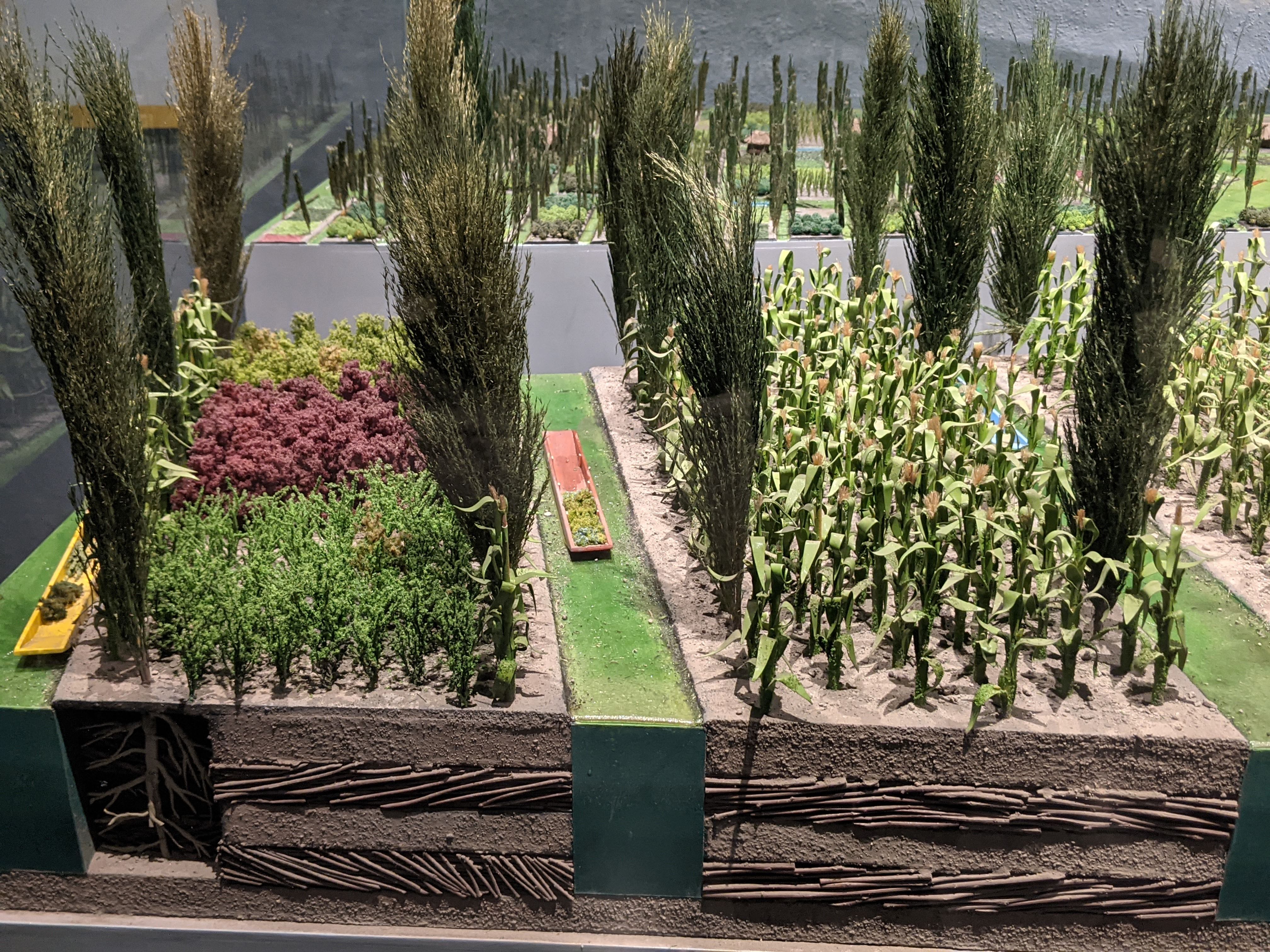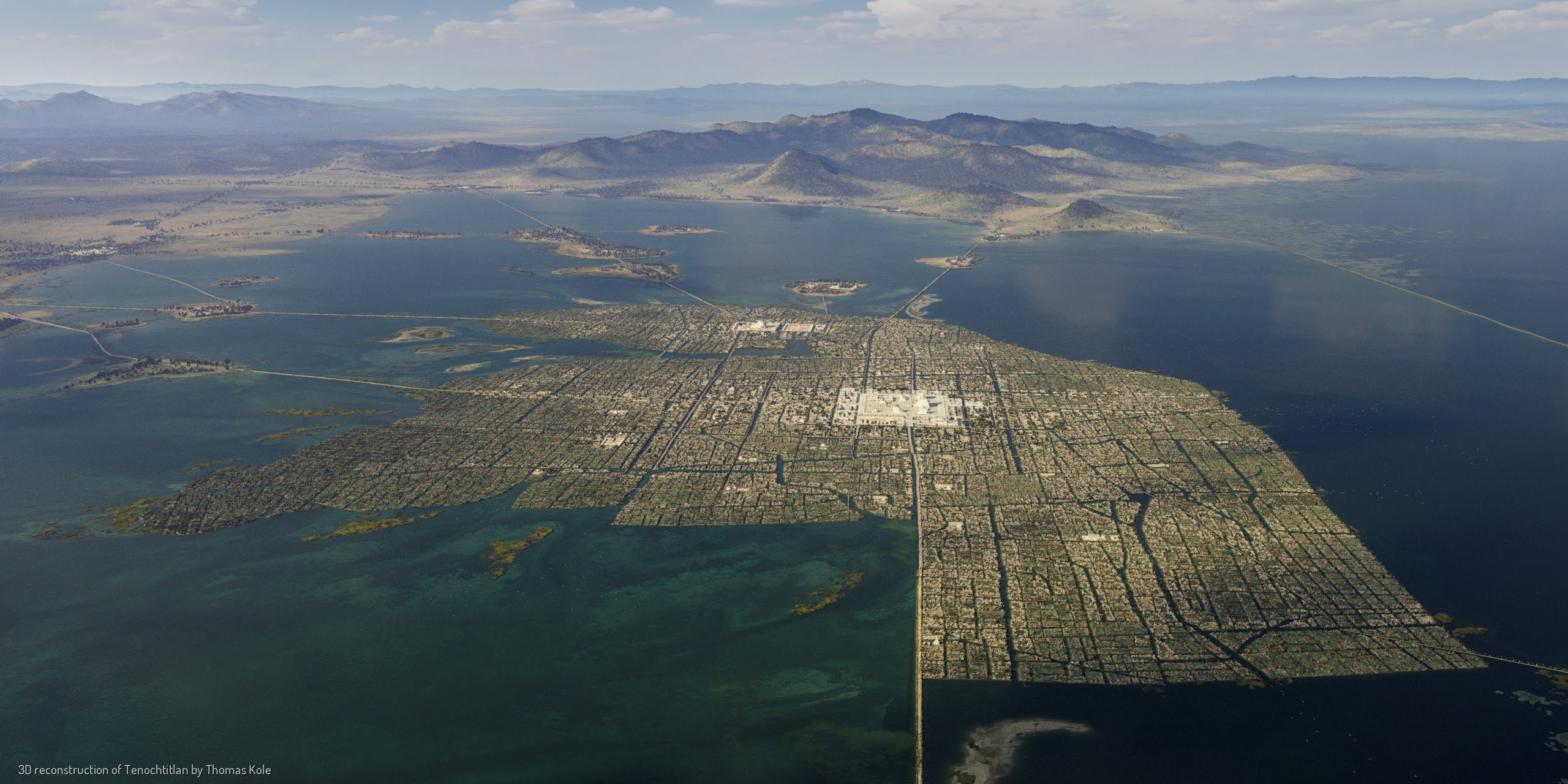It’s a gray August morning on the banks of Lake Xochimilco (so-chee-milko), a maze of canals and tiny islands, just a few blocks away from the highways and high-rises of the southern edge of Mexico City. The sounds of Mexican pop music mix with shouts from a nearby soccer game as I wait for our tour guide to load the canoes. The land here was hand-built many centuries ago — the remnants of a highly productive urban farming system that once fed the dazzling city of Tenochtitlan. That Aztec capital city was sewerless, waste-free and sparkling clean, sustained by a city-wide system that recycled food scraps and human poop to fertilize these nearby farms.

Our guide Francisco Javier Juarez is a biologist from Mexico City and a member of Humedalia, a nonprofit that promotes cultural and wetland preservation. They also farm one of the islands, our destination. I step gingerly into the canoe and we wait for a brightly colored party boat to pass by before paddling across the main channel. We head east, past snowy egrets and night herons, soccer fields and food stalls. The waterways split and turn, a labyrinth of dark water threading through lush green islands.
This system of farming, called chinampas, developed in the Valley of Mexico around a thousand years ago. Farmers created islands by staking out rectangular sections in the shallow lake, then filling them with brush and fertile lake-bottom muck. Layer by layer, like lasagna, the islands rose from the water. Willow trees planted along the borders stabilized the new land. Chinampa farming was small-scale before the Aztecs came to power.
.jpg)
The Aztec’s island city
In the early 1300s, a group of people we now call the Aztecs migrated here from the north. They arrived in the Valley of Mexico and found a blanket of shimmering lakes across hundreds of miles, and wetlands noisy with the trills of birds. The only land available for the newcomers was a marshy island in Lake Texcoco, so they settled there. To grow their city, they used chinampa technology. Farmers lived on the islands and crops grew year-round. The new land expanded the city and fed its people, who in turn provided the nutrients that fertilized the soil to grow more food.
By 1519, Tenochtitlan was a bustling city, home to as many as 200,000 people, then one of the largest cities in the world. It was so magnificent that when Europeans first laid eyes on it, they “scarcely knew what to think” and wondered “whether all that we beheld was real,” wrote Bernal Díaz del Castillo, a Spanish invader traveling with Hernán Cortés.

In Europe at that time, urban waterways were polluted by feces. From rivers in London to canals in Venice, Europeans drained sewage into the water. There, tides or rivers eventually swept away the polluted water, but not in the Valley of Mexico — it had no natural outlet. The Aztecs developed a mindset worlds apart from the “out of sight, out of mind” mentality which shaped the polluting sanitation systems of Europe (and America).
And Tenochtitlan sparkled. A thousand workers cleaned the city streets, washing dust into the lake — but never urine, feces or organic waste. The surrounding waters teemed with life: aquatic plants, insects, fish, axolotls. Farmers and fisherpeople canoed food to the markets. One enormous market served a dizzying array of foods, goods and services including “delicious bars of dried algae from the lake,” writes Camilla Townsend in The Fifth Sun: A New History of the Aztecs.

Markets for pee and poo
Markets were organized by merchandise type, with sections for luxury goods, wood products, fruits, vegetables, meats, pre-cooked food and so much more, including human excreta. Urine, collected in clay pots from homes across the city, was distributed in the largest market. Díaz del Castillo described this place in detail, including the human excrement for sale in canoes at the docks. He noted that toilets were placed along every road, “so that great care was taken that none of the last-mentioned treasures should be lost.” Public and private toilets collected feces for fertilizer or for tanning animal hides, and urine served as a mordant — a substance to help fix dyes into cloth.
Though the Spanish were awed by this place, they had not come to learn how to recycle urban nutrients and protect the environment — they wanted gold. Just two years after their first visit, Tenochtitlan was destroyed and the Spanish ruled. The European contact sparked a smallpox epidemic that quickly killed nearly half the population and led to a famine. This paved the way for Cortez’s military takeover of the city. He destroyed the drinking water system, burned the libraries and smashed the temples. On the ruins, he built what became the Mexico City we know today. Quickly, the canals around the city reeked, filled with garbage and sewage. Later, the Spanish started draining the lakes.
Now, most of the lakes and wetlands are gone. What remains is polluted by sewage and street runoff, harming the wildlife in Xochimilco. Invasive species displace native ones. Many, like the axolotl, hover on the brink of extinction.

And yet, even polluted this place is magical. We pass fields of dark, fertile soil where marigolds bloom gold and corn stalks tower over squash vines. Chiles, amaranth, lettuce and sunflowers fill the fields. Pink trumpet flowers droop to the water’s edge, kissing their reflection under the bright sky. The biodiversity is stunning: this area holds two percent of the entire world’s biodiversity and eleven percent of Mexico’s.
Today there’s about one percent of the original chinampas left, and of those a small fraction are still farmed. The rest are soccer fields, party huts and food stands. “It’s kind of sad,” Juarez says, “some of the ancient techniques are getting lost, but not all of them.” He reminds us that this is living history. The whole area is recognized as a UNESCO World Heritage Site, and the Mexican government designated it a historic site, on par with the pyramids of Teotihuacan.
.jpg)
Visiting a Chinampa
We reach Humedalia’s chinampa and climb onto the banks. The farm buzzes with flowers and veggies, herbs and sunflowers. There is a bathroom, too, a simple structure made from cob with a urine-diverting dry toilet inside. The dry toilet keeps feces out of the lake, but the humanure is not recycled as fertilizer, Juarez tells me. He’s not familiar with the practice.
After wandering the farm, our group gathers in their outdoor classroom to learn about the wetlands and legends of this land. Juarez is animated as he talks about axolotls and chinampas and preserving the Nahatl (NA-wat) language, the indigenous language here. Smoke from the wood cookstove drops tiny ashes in my lap and carries the aroma of our lunch. We share delicious food made with ingredients grown on this farm, sitting under a roof thatched with reeds from the chinampa.

I imagine what it was like back when nutrients cycled at a grand scale in Tenochtitlan — moving from farm to food to fertilizer and back to the farms. This lesson feels very much alive, surviving in the soil beneath my feet. It’s one of balance and sustainability, a glimpse of how urban life can be interwoven into a thriving, healthy ecosystem.
Before we leave, Juarez takes us to the nursery to choose a start. He shows us how to dig into the soft brown soil for the transplant. I choose a sunflower plant: It's small and delicate, with promise of the big, beautiful flower to come.

Laura Allen is a writer and educator based in Oregon. She co-founded Greywater Action, where she teaches people how to transform their homes to reuse water. She authored the books, The Water Wise Home: How to Conserve, Capture and Reuse Water in Your Home and Landscape, and Greywater, Green Landscape. Her article, For a better brick, just add poop, won the Gold Award in Children’s Science News from the AAAS Kavli Science Journalism Awards (2023). Her favorite pastimes include gardening, hiking, reading and visiting eco-toilets.



.png)
.jpg)
